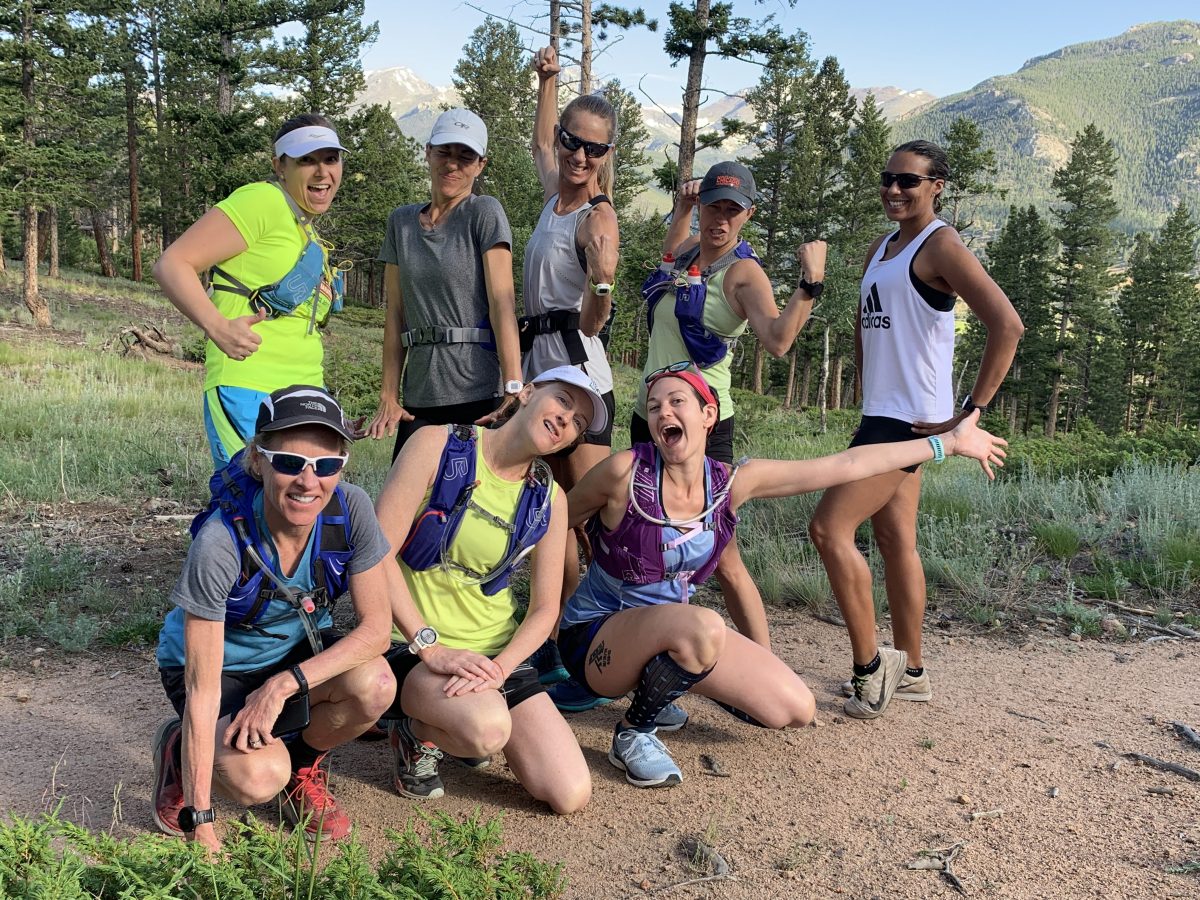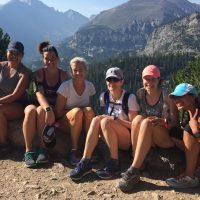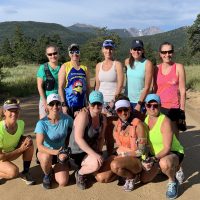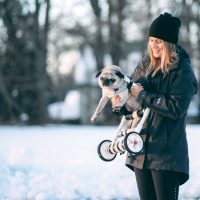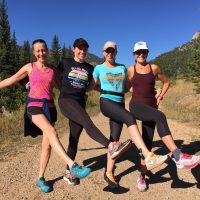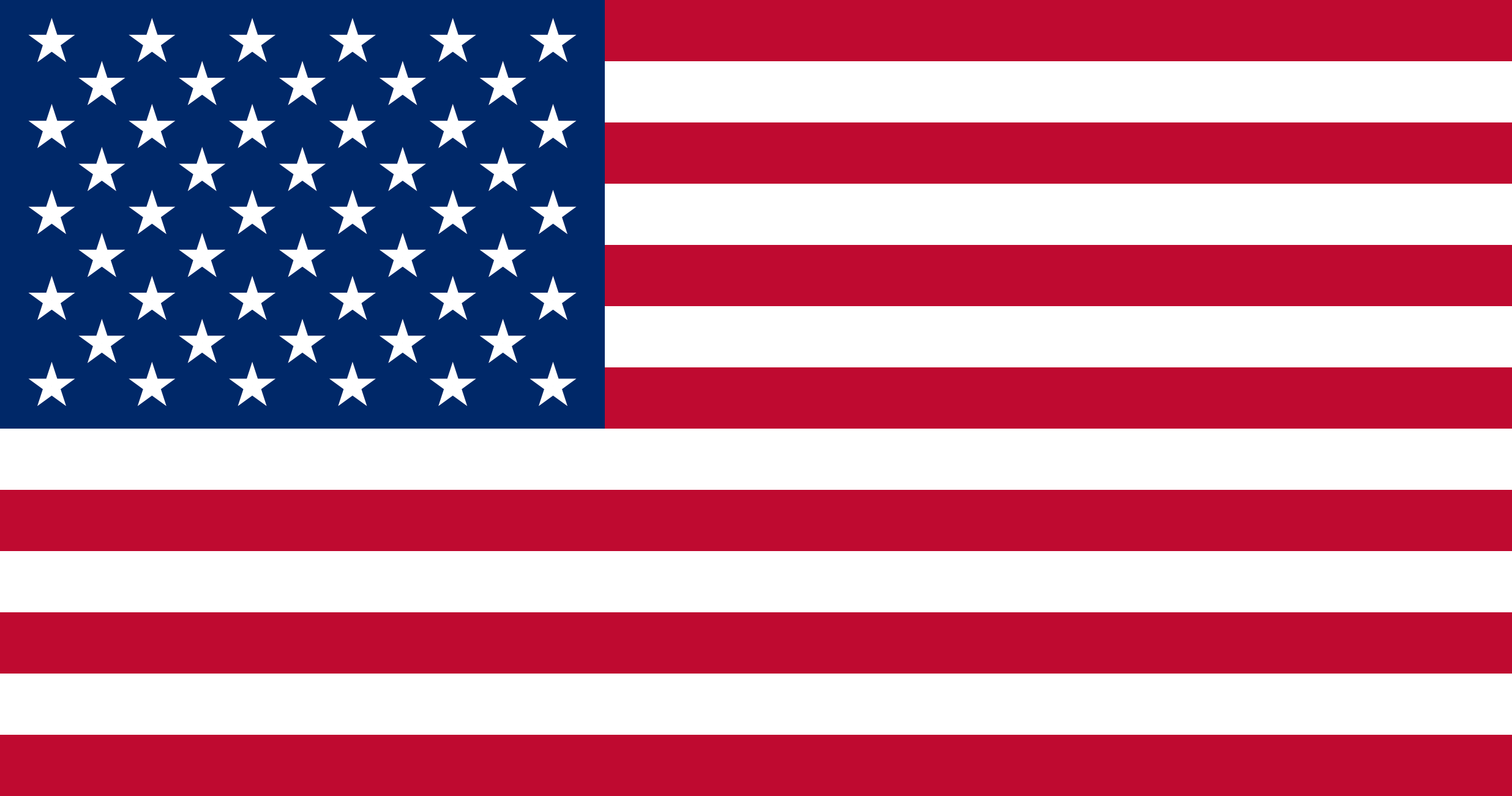Our positive running story this time is on Robin Pike, a runner and flautist from Silver Spring in Maryland, close to Washington. Robin attended one of our women’s running camps in July (the same camp as our previous story on Mimi). Robin has several epiphanies during the camp that were so encouraging and inspiring to see. She is also a fount of positivity and a wonderful support person for every runner around her. (Robin is pictured above at camp in July, at the right end of the front row). We recently asked if we could interview Robin for our positive running story series, and here is the result of our interview:
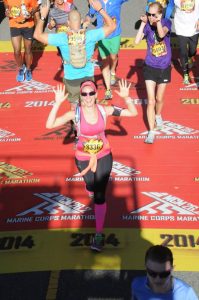 Can you share your brief running history to date?
Can you share your brief running history to date?
While I was an active child, I began running in Pittsburgh, PA in 2006 while in grad school, to destress, to procrastinate writing research papers, and to tire out Pete so I could focus. (I rented a room in a house from a woman who had the dog, Pete, who was an older but high-energy shelter dog.) If I tired Pete out with a long walk or run through Frick Park, a massive natural park, or other neighborhoods, he would keep my feet warm for hours while I wrote, and be a calming presence in a stressful time. I don’t know how far or how long I would run, but it was enough to build up ideas and feel less stressed about writing. After grad school when I moved to DC for work, I ran a little but the scenery wasn’t as beautiful as where I had started and my then undiagnosed fibromyalgia pain was getting worse so I dropped off for a few years. I picked running back up in 2011 as my first round of physical therapy for fibromyalgia ended to keep active and moving, a key to pain management. I’ve been running regularly ever since, minus the time I had to take off for tibia strain in 2015-2016 and for a stress fracture in 2019. I ran my first road race in 2012 to have a goal to work towards and I’ve tried to run a few races per year (minus time recovering from injury), focusing more recently on finding races in places that I would like to visit.
What are the top three things that you enjoy most about running, and why?
Running is healing. The more I move, the more endorphins I build up and the easier I can manage my hypermobility and fibromyalgia pain without taking as much medication. While lower-impact cardio like swimming and cycling help some, I haven’t found a full-body workout that works better for me to manage pain.
Running is meditative. In grad school, I struggled with panic attacks and insomnia. I’ve had other stress-induced health issues (like teeth grinding and tension headaches) since then. With running, especially distance running, I feel like some of the stress washes away, and I don’t have nearly as many issues (I haven’t had another panic attack or insomnia since).
Running makes me feel strong. I’ve struggled with other health issues that make me feel fragile or at least tentative and afraid of taking risks. Building up long-distance running and strength training to support that running makes me feel a physical strength and mental fortitude that carries over into other areas of my life, as a manager at work and as a leader in professional organizations.
As a bonus favorite thing, I love the community I’ve formed because of running. My social run club (and my Ladies of Run Club Book Club) are two of my most favorite activities because I get to be friends with other strong and accomplished women (and cool guys, too). And I loved the amazing group of diverse women I met at camp.
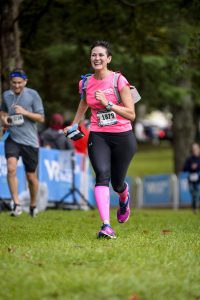 You have experienced fibromyalgia as a runner. Recently the causes and treatment of fibromyalgia have been getting some press coverage. What has your experience been of fibromyalgia, and what has this meant to your running?
You have experienced fibromyalgia as a runner. Recently the causes and treatment of fibromyalgia have been getting some press coverage. What has your experience been of fibromyalgia, and what has this meant to your running?
I started experiencing intermittent pain in different areas of my body at about 11 and it became a constant part of my life at 19. After seeing 12 doctors over many years, I was finally, properly diagnosed with fibromyalgia and hypermobility at 25. Being diagnosed is a long process because there is no one test to diagnose the conditions—rather it’s a series of eliminating what it’s not while looking for out-of-place inflammation markers. The research is still out on whether fibromyalgia is a nerve, muscular, or vascular condition, but it’s altogether unpleasant. It’s also a challenge because over the years many doctors told me that the pain was in my head, that they “didn’t know why I was feeling pain” (an actual note I have from an orthopedist), and that I should not do the thing that was causing pain (I had to quit gymnastics, wasn’t allowed in marching band, and was told to quit playing flute when I was a music major). With hypermobility, my muscles are tight because my core stabilizing muscles and tendons are naturally loose and my body tries to protect joints in other ways; my main symptoms are muscle pain from massive knots and inflammation of joints. My fibromyalgia symptoms are typically overactive nerves, muscle pain, fatigue, and brain fog.
The biggest change was that I need to be more disciplined about my health. I found a doctor who was understanding and supportive and flexible with changing my treatments over the past decade and I see her several times a year. I also found a physical therapist who was willing to not just give me basic treatment to get me feeling better, but was on board with setting much harder goals and getting me in shape for them. I have to do physical therapy nearly every year for at least a few months as a tune-up. I have to limit flare triggers (drinking alcohol, eating fried foods, not getting enough sleep, exposure to cold weather or fluctuating weather, too much exercise, etc.). I need to remember to do my at-home physical therapy strengthening exercises. I have to be incredibly adaptive in any training program, giving myself more rest time, not aiming for high weekly miles, and being more forgiving of myself when I have to miss a day or multiple days because of a flare. In the past, I would be stubborn and push through, making the pain worse or injuring myself (shin splints turned in a 9-month tibia strain episode). I’ve had to learn to be patient and kind to myself which makes set-backs not as crushing as they once were.
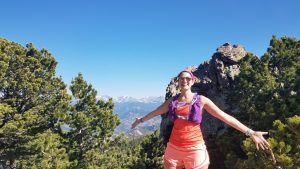 You attended one of our women’s running camps this Summer. What was it that attracted you to the camp, and what were your three biggest epiphanies during the camp?
You attended one of our women’s running camps this Summer. What was it that attracted you to the camp, and what were your three biggest epiphanies during the camp?
I found out about the camp right after I completed the Vacation Races Great Smokies Half. I love national parks and have dabbled at trail running and saw the camp as an opportunity to improve while enjoying amazing scenery. I had also just finished a 7-month stint of physical therapy and was looking for a celebratory challenge. I also like to do a big challenge for every fifth birthday and running up a mountain seemed like a good challenge for turning 35. Everything fell into place and the Active at Altitude camp felt right.
Learning about the Lydiard training schedule made me realize why I always injured myself with generic training plans, which incorporate speed work early in the plan before focusing on strengthening, or might not focus on strength at all. I need to focus more on strength training, especially because of my inherent muscular issues.
I learned how to properly cross-train and its importance in a training plan. Previously, if I would cross-train, I would do exercises to induce a lot of sweating on days when I wouldn’t run, not giving my body a low-impact day to heal. I also learned movements that will strengthen my core-stabilizing muscles and will lead to all-over better health as well as a better running form which will prevent injuries.
Finally, and most importantly, I began to overcome my fear of being fragile. In December, I began having what I thought were muscular pains in my left glute and groin, which continued to get worse. After a series of diagnostic tests, my doctor discovered a sizable stress fracture in my femur. I had surgery to repair it in March. I worked so hard to get back in running shape for the camp in mid-July but I still wasn’t feeling confident and strong. I faced my fragility in the imagery session Terry led and felt a huge release after I acknowledged it and decided to kick it to the curb. Through the cross-training sessions, I also realized that though I may have to work harder to strengthen or maintain certain muscles, the existing weaknesses I’ve been told I have aren’t permanent and are changeable.
Our camp really seemed to help you get to know and understand your body more. What impact do you think this will have on your running future?
I will be more thoughtful with my training and think of training not just as what I do in the 16 weeks before a race, but as a years-long process. Since camp, cross-training has become a larger part of my life and I keep trying to make more time for strength training. Every year, my goal was to feel well enough to not need physical therapy, previously viewing this as accepting a setback, but I now realize that PT plays an important role in getting me to the next level—a tune-up is not a regression. Taking a holistic, preventative approach to my health, and including running in that plan, is the key to overall better health.
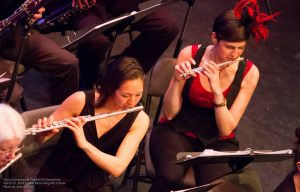
You play the flute in an orchestra in DC. Is there anything about music and your role in the orchestra that also helps you as a runner?
Music is a balance between technique and interpretation. You need to master the technique—the tone, notes, rhythm, how to articulate each note, phrasing, and the composed style of the music—before you add musicality. If you don’t spend time on technique, you’ll hurt people’s ears. Running is similar in that you should master techniques like good running form, cadence, and breath control before you build up to complicated speed work or running trails, otherwise you can hurt yourself. It takes years to become knowledgeable in the foundations for both activities and I’m constantly learning and perfecting my skills in both.
What wisdoms would you share with a younger version of yourself about being a woman runner?
Like many young women with a naturally curvy figure, I struggled with body image issues in my teens and early 20s. I would tell my younger self that being strong and letting your body take on whatever shape is necessary for that strength to exist is so much more important than fitting into a style of clothes or trying to have an “ideal” body type. And don’t be afraid to wear short running shorts even if it shows your cellulite because it’s 90-something and humid and it’s just too hot to wear anything else, and who cares if other people have opinions on that anyway. And I would tell my younger self that just because other people treat her like she’s sick or going to break at any moment, doesn’t mean they know her capability as well as she does and to go for what makes her happy.
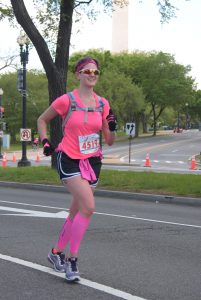 If we could share one message on your behalf to the World, what would you want to say?
If we could share one message on your behalf to the World, what would you want to say?
I would encourage people to be more empathetic towards each other. Having empathy would go a long way to solving a lot of internal, interpersonal, and international conflicts.
Can you share one thing that is unique about Robin that no one would know by looking at you?
My current love of reading travel writing grew out of my childhood love of reading fantasy and sci-fi, except now I’m picturing myself in and planning to go to places that actually exist.
What are your goals for the rest of 2019, and beyond?
I want to be stronger and be injured less often. I will start running trails more because I fell in love with the challenge of the terrain. I would love to build back up to races longer than a half marathon, but now I know to do that gradually. Beyond running, I want to help my female friends and colleagues find their inner strength and help them be kinder to themselves.
Robin, thank you so much for taking the time to share your story with us, and we look forward to many more years of running for you! We wish you success with gaining strength and remaining healthy and consistent. Strength and kindness are two of your core qualities.
Would you like to be a part of the Positive Running Movement®? Our monthly newsletter contains more positive running stories and tips on how to get the best from your positive mind as an athlete.
Sign up for our newsletters on this page – we look forward to hearing from you!

